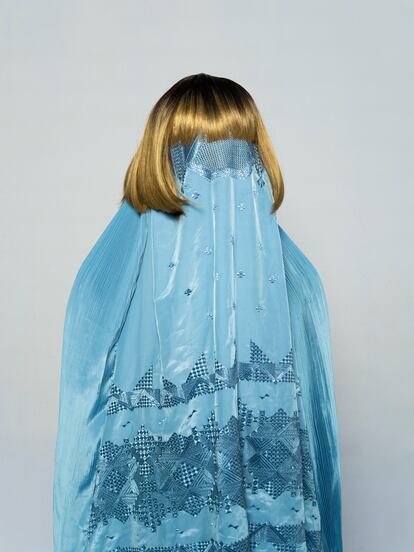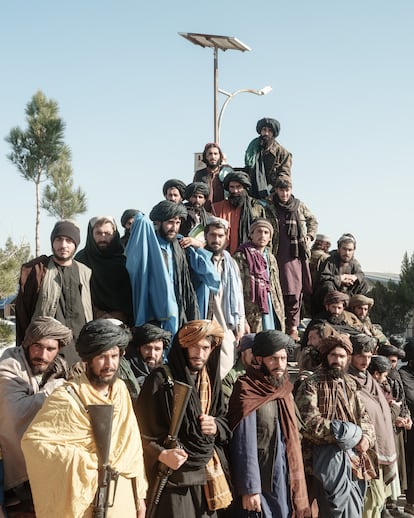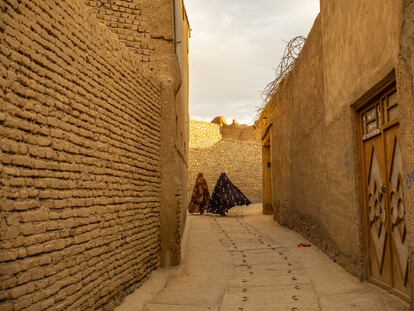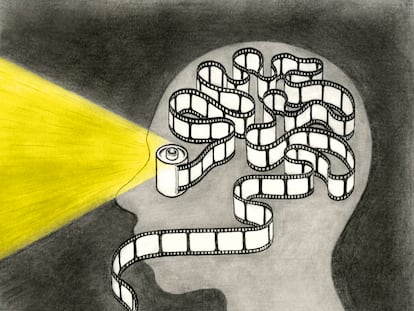‘The Kabuler’: Magnum photographers Cristina de Middel and Lorenzo Meloni demystify Afghanistan
Over the course of 30 days, the authors captured images that they featured in a magazine-format publication. Their project repositions the audience’s point of view on the country by treating it in an unusually relaxed way

Over the past two decades, Afghanistan has been one of the regions of the world that the media has documented the most. Even so, when it comes to getting a general idea of the situation in this war-ravaged country, we face many myths that underlie and complicate our interpretation. Interest in the country has been tailed off after the withdrawal of international troops from Afghan territory in 2021. That led Cristina de Middel and Lorenzo Meloni to revisit the narratives surrounding one of the countries that has been a main player on the world stage since the turn of the 21st century.

In January last year, the two photographers traveled the length and breadth of Afghanistan to document a new period in its history marked by the Taliban’s return to power after 20 years of war with the United States. Their intention was to gather enough information, in thirty days, to shape The Kabuler. Its authors conceived the publication as a nod towards Western weeklies and the special issues that magazines often devote to places or topics that are not under constant scrutiny. The magazine-format publication is made up of interviews, reports, opinion articles, lighthearted sections that also include humor, and texts by several contributors. In it, the duo aims to offer a more unusual look at Afghan society and to provide a space for the different voices that make it up.
One of those voices is Mullah Abdullah Sarhadi’s, the one-eyed governor of Bamiyan. He was one of the men responsible for the destruction of the giant Buddhas in his province. He is also implicated in the massacre of the Hazaras, and is an Guantanamo ex-convict. More recently he has been accused of overseeing the looting of Buddhist antiquities in the area. In an interview, he introduces us to this melting pot of experiences that will also lead us on to discover one of the discreet beauty parlors where women paint their nails (for which they can have their fingers cut off), have their hair curled, or put in hair extensions that will be hidden under the burqa. In one of her features, journalist and writer Jean Marie Ward compares George Lucas’ Star Wars to the war in Afghanistan, based on what an Al Qaeda fighter told CIA officer Amaryllis Fox: “What you don’t realize is that, in the rest of the world, you are the Empire. We are Luke and Han.” Similarly, the past glories of the mujahideen and Taliban are on display in the Jihad museum, “a symbol of a divided present rather than a shared past,” as Johan Faes points out; while colorful rickshaws and their drivers, who work up to 15 hours a day to earn about four dollars (wages have been halved since the return of the Taliban), make up the chapter dedicated to the engine. Cooking, fashion, a word puzzle and, of course, a classifieds section, in which a stocky member of the Taliban with a gun invites us to celebrate whatever we like at the Stars Palace, complete the other themes. The relaxed publication is dotted with powerful portraits and unusual images of everyday life in the Middle Eastern country.

Both photographers are part of the Magnum agency (of which De Middel has been president since last year). The Spanish photographer’s career has been defined by a conceptual photography through which she plays with reality. Her photographs question the excess of truth that is granted to the photographic medium as an authenticating document. In contrast, Meloni’s work is framed in the depiction of different armed conflicts and the toll they take on people and the landscape. Their different approaches to photography would serve to reflect the coexistence of the two complementary tendencies (documentary and artistic) that are the backbone of their cooperative work. It was precisely as a result of a conversation the authors had about whether art and photojournalism, fiction and truth, can coexist or not, that the idea of joining the two visual languages came about, and that gave shape to the project about a country unknown to both photographers. “We decided to give it a try,” De Middel explains. “This was experimental work in which we would not give any of the approaches special treatment. Meloni is a war photographer. His photography is the result of a more exhaustive approach. His photos need to be explained, while I work in a more conceptual field where I don’t need so many checks, just visual anchor points that allow me to speak with images. However, this project has taught me to be more thorough and more demanding.”
Since its foundation, Magnum has fought to defend the independence of its members (whether or not the medium in which the photographers publish is independent is beyond its control). “More than for truth or objectivity, the fight is for the photographer’s personal voice,” De Middel says. “When many subjectivities are added together one gets as close as one can to the truth. A single explanation of things in a world as complex as the one we live in is nonsense. The moment we understand that to get closer to objectivity, or to the truth, we have to bring together the maximum number of opinions and subjectivities, maybe we will make some progress,” she adds.

Similarly, behind The Kabuler is the need to remind the public of the importance of seeking new narrative formulas in a world continually transformed by technology. “If a few years ago the media had exhausted its ways to explain things, we are now experiencing a reinvention,” says the photographer. “Newspapers are more visual than ever. There are interactive and multimedia pages in the digital versions of newspapers. But even so, the perspective given to the issues, not only through photography but also in the text, is almost always the same. For example, with the war in Ukraine we are seeing that only one point of view is being offered. I’m not saying one is true and the other is a lie, but other versions of the war are published in Russia and Putin-friendly countries. The Kabuler tries to emphasize the need to incorporate all that we have missed in order to decipher the complexities of a conflict.”
The publication also alludes to the difficulty readers have in navigating between a constant flow of information and the tendency to succumb to platitudes, which would appear to simplify our understanding of the world. Hence, one of the articles offers a list of the 12 most clichéd representations of Afghanistan, put together with the help of ChatGPT: “Regarding the use of artificial intelligence, I think we are at a very tricky point in time because we don’t know how far this can go, or the consequences,” says De Middel. “I’m afraid that controlling it is going to be difficult. It’s as if we had given a Formula 1 car to a child to drive around central Madrid. I believe that in the field of photography the consequences are going to be terrible in terms of fake images, but this is precisely what will cause the authorities to take corrective measures. Manipulating the audience is a very serious matter.”
This project was born with the hope that it will continue. “We will continue to expand the publication,” says De Middel. “We want it to be a kind of structure for the Magnum family. Or maybe it will be just the two of us, if no one else is up for it, so that we can continue to increase people’s understanding and demystify places that are very stigmatized.”
Sign up for our weekly newsletter to get more English-language news coverage from EL PAÍS USA Edition
Tu suscripción se está usando en otro dispositivo
¿Quieres añadir otro usuario a tu suscripción?
Si continúas leyendo en este dispositivo, no se podrá leer en el otro.
FlechaTu suscripción se está usando en otro dispositivo y solo puedes acceder a EL PAÍS desde un dispositivo a la vez.
Si quieres compartir tu cuenta, cambia tu suscripción a la modalidad Premium, así podrás añadir otro usuario. Cada uno accederá con su propia cuenta de email, lo que os permitirá personalizar vuestra experiencia en EL PAÍS.
¿Tienes una suscripción de empresa? Accede aquí para contratar más cuentas.
En el caso de no saber quién está usando tu cuenta, te recomendamos cambiar tu contraseña aquí.
Si decides continuar compartiendo tu cuenta, este mensaje se mostrará en tu dispositivo y en el de la otra persona que está usando tu cuenta de forma indefinida, afectando a tu experiencia de lectura. Puedes consultar aquí los términos y condiciones de la suscripción digital.
More information
Archived In
Últimas noticias
Most viewed
- Sinaloa Cartel war is taking its toll on Los Chapitos
- Oona Chaplin: ‘I told James Cameron that I was living in a treehouse and starting a permaculture project with a friend’
- Reinhard Genzel, Nobel laureate in physics: ‘One-minute videos will never give you the truth’
- Why the price of coffee has skyrocketed: from Brazilian plantations to specialty coffee houses
- Silver prices are going crazy: This is what’s fueling the rally











































